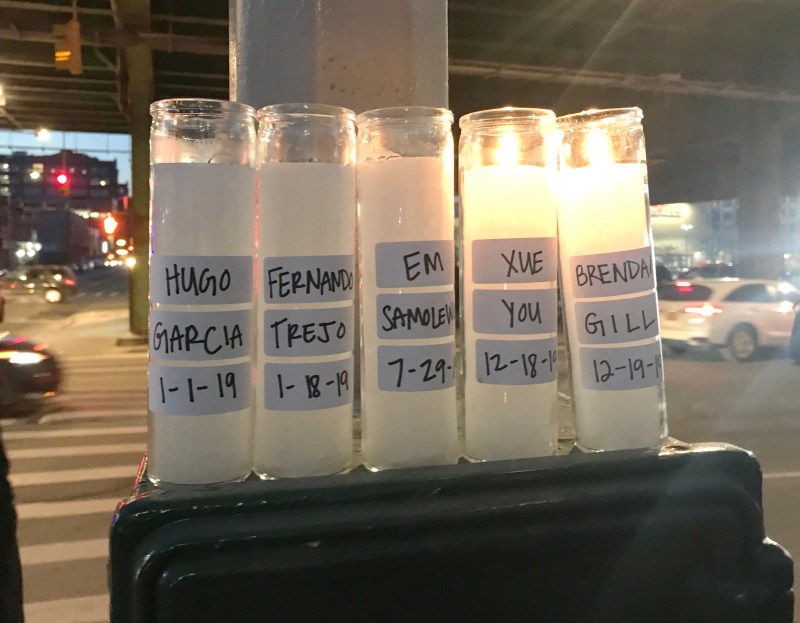OPINION: Sunset Park Can’t Wait for the Brooklyn Greenway and a Third Avenue Redesign
It’s time for the Department of Transportation to focus on immediate structural investments and street planning for a neighborhood that has suffered far too much loss.

In advance of tonight’s vigil for the latest Sunset Park cyclist to be killed on Third Avenue, Council candidate Whitney Hu offered these thoughts. The vigil will be held at 5 p.m. at Second Avenue and 55th Street, near the site of Clara Kang’s death.
Sunset Park is one of the most dangerous neighborhoods in the city because of our streets. Last year, we had almost seven crashes per day, five Sunset Park residents were killed, and hundreds more were injured. Yet, the Department of Transportation has been slow to make our streets safer for pedestrians, cyclists and motorists even as the community comes together to demand changes at vigil after vigil.
Clara Kang was a beloved nurse who was struck down and killed after working an overnight shift at NYU Langone–Brookyn. She was biking home on Third Avenue and 56th Street, just a few blocks away from the South Brooklyn Mutual Aid warehouse. I looked at the warehouse’s full bike rack and felt the dread of knowing that it could have easily been any of our volunteers.
Clara’s tragic death comes after a year in which Third Avenue was deadly for so many cyclists and pedestrians: Hugo Alexander Sinto Garcia was killed biking to work at 28th Street. Pedestrian Fernando Trejo was killed in a hit-and-run at 52nd Street. Em Samolewicz was killed by a driver at 36th Street. Brendan Gill was walking home when he was killed on 39th Street.
Last summer, at the vigil for Samolewicz, Rep. Nydia Velazquez pushed on DOT to finally finish the elusive South Brooklyn part of the Brooklyn Greenway to finally connect Brooklyn’s waterfront communities. Rep. Velazquez secured over $14 million in federal funding in 2005 for this project. More than 15 years later, Red Hook and Sunset Park are still left waiting.
It’s beyond time for the DOT to finish the Brooklyn Greenway to give pedestrians and cyclists a safe path. In addition, DOT must redesign Third Avenue with better crosswalks that include reflective crosswalk signs, flashing lights and nighttime lighting. DOT should also take into consideration parking restrictions, especially nearby crosswalks, which can obstruct drivers’ vision. DOT should invest in speed humps to slow down drivers, especially in high-trafficked areas.
It’s also important for DOT to consider putting a dedicated bus lane on Third Avenue and connect people to the working waterfront safely. Buses are accessible and friendly to those who have limited mobility, seniors and families, thus offering greener solutions to those who are unable to walk or bike long stretches.
The proposed Brooklyn Greenway would finally put a protected path on the deadly corridor between Hamilton Avenue and 65th Street under the Gowanus Expressway. DOT Commissioner Polly Trottenberg admitted herself that this area was deadly, and late last December lowered the speed limit from 30 mph to 25 mph. But Trottenberg did not select Third Avenue in DOT’s Green Wave in pre-pandemic 2020, instead pushing the Greenway back again to 2021 for a supposed (and dubious) full implementation. Sunset Park did get protected bike lanes on Fourth Avenue, but these bike lanes had been slated to be completed in the spring, 2018.
With COVID-19, many New Yorkers have turned to biking instead of commuting on subways to reduce the risk of spread. Sales of bikes have nearly doubled nationwide and there’s a shortage in bikes in New York City. According to CrashMapper, in just one month — September — Sunset Park had 88 total crashes, with 10 cyclists injured. It’s important and critical that DOT and the mayor prioritize protected bike lanes and pedestrian pathways, especially in communities of color like Sunset Park.
This is critical because of how Black, Indigenous, and People of Color are always deprioritized in conversations of street safety, even though BIPOC communities often suffer the most from unsafe streets and heavy traffic. It is also important to note that campaigns like Vision Zero often push more law enforcement into communities of color, even when they list officer-initiated enforcement as a last resort. When we talk about street safety, we must do so through a racial justice lens and make sure we’re fighting for equitable measures that include actual investments and street planning to make our roads safer.
It’s also time for DOT to listen to Community Board 7, which has been demanding more action to reduce the impact of trucking. Better understanding the effects of truck use is critical because many Sunset Park residents are in close proximity to the Gowanus Expressway, which also has been linked to the high rates of asthma seen in a community that holds essential workers, immigrant families and more, who have been disproportionately impacted by the effects of COVID-19. This trucking study would come at a time when developers continue to place as-of-right last mile trucking facilities into the community which erodes not only street safety, but fully contradicts the community’s desire for climate justice and health.
It’s critical in this space and time that we work on creating livable, truly safer cities. This means we must plan and create infrastructure and streets that prioritize pedestrians and alternative modes of transportation and climate justice. For those who we have lost and for all of us who remain in the city.
Whitney Hu is a community organizer and running for City Council Candidate for District 38. Follow her campaign on Twitter @whitney_hu.
